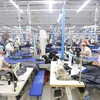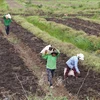Financial institutions must play a more active role in promoting sustainable hydropower development in the lower Mekong river basin, the World Wide Fund for Nature (WWF) has said.
Leading US, European and Asian financial institutions on Sept. 24 attended a conference co-convened by WWF and other development partners in Bangkok to highlight the financial, social and environmental risks and responsibilities of hydropower development on the lower Mekong river.
The meeting will also explore ways to understand and mitigate these risks.
"It is a missed opportunity," said Marc Goichot, sustainable infrastructure senior advisor for WWF Greater Mekong.
" Lower Mekong dam sites were selected in the 1960s and there has not been a process to review them with the benefit of today's science and technology."
Currently, there are 11 hydropower dams proposed for the lower Mekong river, which runs through Laos, Cambodia, Thailand and Vietnam.
If one of these dams is built, it will break the lower Mekong's ecosystem connectivity, which can have a cascade of negative effects.
"Putting a dam on the lower Mekong River will block fish migration to spawning grounds, collapsing fish stocks," said Michael Simon, head of the People Infrastructure and Environment Programme of Oxfam Australia .
"Do lenders want to be associated with putting the food security of 60 million people in some of the world's poorest countries at risk?" he added.
Forecasts show the productivity of lower Mekong fisheries, which is valued up to 7 billion USD annually, would drop by up to 70 percent by lower Mekong mainstream dams.
In addition, iconic species such as the Mekong giant catfish and Mekong dolphin would face likely extinction if the proposed dams go ahead.
"Hydropower projects can limit their impact to ecosystem connectivity. For example, a large dam can be built in the floodplain beside a river channel rather than across it, or a hydropower project can have no dam at all," said Goichot.
In southern Laos , there is such an alternative being proposed by the Lao Department of Electricity and semi-state owned French company CNR (Compagnie Nationale du Rhone)./.
Leading US, European and Asian financial institutions on Sept. 24 attended a conference co-convened by WWF and other development partners in Bangkok to highlight the financial, social and environmental risks and responsibilities of hydropower development on the lower Mekong river.
The meeting will also explore ways to understand and mitigate these risks.
"It is a missed opportunity," said Marc Goichot, sustainable infrastructure senior advisor for WWF Greater Mekong.
" Lower Mekong dam sites were selected in the 1960s and there has not been a process to review them with the benefit of today's science and technology."
Currently, there are 11 hydropower dams proposed for the lower Mekong river, which runs through Laos, Cambodia, Thailand and Vietnam.
If one of these dams is built, it will break the lower Mekong's ecosystem connectivity, which can have a cascade of negative effects.
"Putting a dam on the lower Mekong River will block fish migration to spawning grounds, collapsing fish stocks," said Michael Simon, head of the People Infrastructure and Environment Programme of Oxfam Australia .
"Do lenders want to be associated with putting the food security of 60 million people in some of the world's poorest countries at risk?" he added.
Forecasts show the productivity of lower Mekong fisheries, which is valued up to 7 billion USD annually, would drop by up to 70 percent by lower Mekong mainstream dams.
In addition, iconic species such as the Mekong giant catfish and Mekong dolphin would face likely extinction if the proposed dams go ahead.
"Hydropower projects can limit their impact to ecosystem connectivity. For example, a large dam can be built in the floodplain beside a river channel rather than across it, or a hydropower project can have no dam at all," said Goichot.
In southern Laos , there is such an alternative being proposed by the Lao Department of Electricity and semi-state owned French company CNR (Compagnie Nationale du Rhone)./.



















